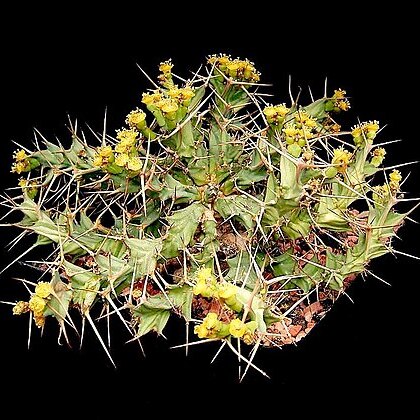Stem simple, with several short underground branches to c. 3 cm long, rebranching ± at ground level; secondary aerial branches erect, 7.5–20 × 1–3 cm, acutely 3–4(5)-angled, usually constricted irregularly into obovate segments c. 2 cm long; angles sinuate with prominent tubercles 5–20 mm apart along the margins.
Caespitose dwarf spiny succulent perennial, with a large, fleshy, tuberous root merging into a short underground stem, to form a body to 30 × 15 cm.
Spine shields 5–8 mm long, triangular, quite separate; spines to 1.5 cm long but much shorter at the constrictions; prickles minute.
Cyathia with cup-shaped involucres to c. 4 × 7 mm; glands transversely oblong, 3–3.5 mm wide, yellow, touching.
Cymes solitary, simple, with cyathia arranged vertically; peduncles 3–10 mm long; bracts c. 2 × 2 mm, deltoid.
Female flower: styles 4.5 mm long, joined for 1 mm, apices spreading.
Male flowers: bracteoles laciniate; stamens c. 5 mm long.
Capsule obtusely lobed, 1 cm in diameter, sessile.
Leaves 1 mm long, deltoid, deciduous.
Seeds not seen.

